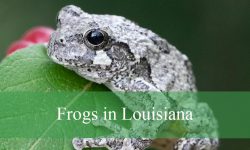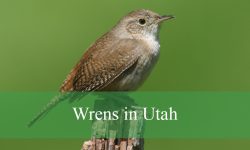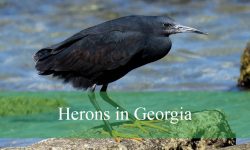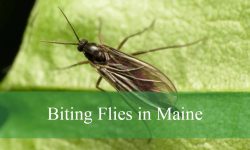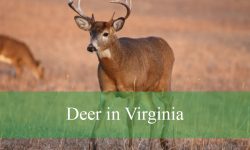Falcons are some of the most fascinating birds of prey in Ohio, admired for their incredible speed, sharp vision, and expert hunting skills. They can be found in a variety of habitats, from bustling cityscapes to open farmlands and along the shores of Lake Erie.
This guide introduces five species of falcons seen in Ohio, complete with pictures, identification tips, and interesting facts. Learning to recognize these agile raptors adds excitement to every birdwatching trip across the state.
Common Falcons You Can See in Ohio
Peregrine Falcon (Falco peregrinus)
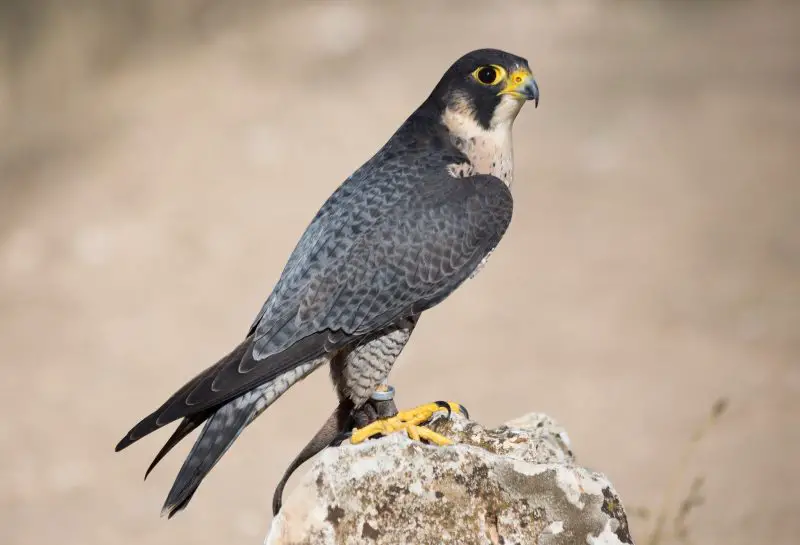
The Peregrine Falcon is a striking bird of prey, admired for its incredible speed and powerful hunting skills. It has a slate-gray back, barred white underparts, and a distinct dark “moustache” mark on its face. Adults typically measure between 14 to 19 inches in length, with a wingspan ranging from 37 to 43 inches. Females are larger than males, a common trait among raptors, and can weigh up to 3.3 pounds. Their long, pointed wings and streamlined bodies are perfectly built for high-speed flight.
This falcon is most easily identified in Ohio by its fast, direct flight and preference for high perches. Urban areas have become key nesting spots, with Peregrines frequently seen on skyscrapers, bridges, and tall industrial structures. Their adaptability to city life mirrors their natural cliff-nesting behavior. In rural areas, they are sometimes spotted along river valleys and near large rock cliffs.
Peregrine Falcons are exceptional hunters, renowned as the fastest animals on earth, capable of stooping (diving) at speeds over 200 miles per hour. They primarily prey on medium-sized birds such as pigeons, doves, shorebirds, and even ducks. Hunting usually takes place in midair, where they strike their prey with incredible precision before catching it. In Ohio cities, pigeons are a major part of their diet, contributing to the species’ success in urban environments.
A fun fact about Peregrine Falcons is their remarkable conservation success story. Once nearly wiped out in North America due to pesticide use, they have rebounded strongly thanks to reintroduction programs. Today, Ohio’s major cities host several nesting pairs, and watching these falcons soar among skyscrapers has become a thrilling sight for urban birdwatchers.
American Kestrel (Falco sparverius)
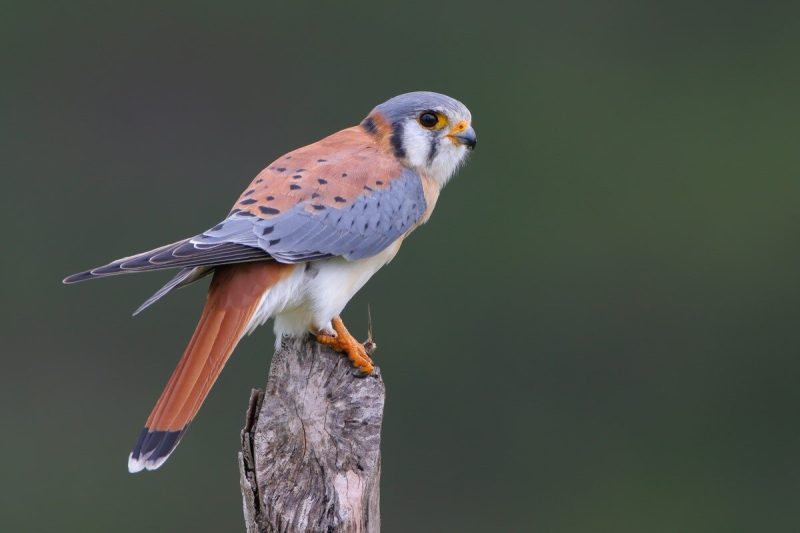
The American Kestrel, also known as the Sparrow Hawk, is the smallest and most colorful falcon in North America. Males display rusty-red backs, blue-gray wings, and a pale orange chest speckled with black spots, while females are slightly duller with more heavily streaked underparts. Adults range from 8 to 12 inches in length, with wingspans between 20 and 24 inches. Despite their small size, they are fierce hunters and highly territorial.
This falcon is easy to identify in Ohio by its habit of perching on telephone wires or fence posts while scanning for prey. It favors open grasslands, farmlands, and fields with scattered trees. Kestrels also adapt well to suburban areas and can sometimes be found in parks or along roadside habitats. Nesting occurs in tree cavities, old woodpecker holes, or specially placed nest boxes.
American Kestrels primarily hunt insects, small mammals, and small birds. Their hunting style is unique; they often hover in midair by rapidly beating their wings while keeping their head steady, a behavior called “kiting.” In Ohio, grasshoppers, voles, and sparrows make up a significant part of their diet. Their excellent eyesight allows them to detect even the slightest movement from a distance.
A fun fact about the American Kestrel is that it can see ultraviolet light, allowing it to detect the urine trails of small mammals. This incredible adaptation helps it locate prey even in tall grass, making it one of the most efficient hunters despite its small size.
Merlin (Falco columbarius)
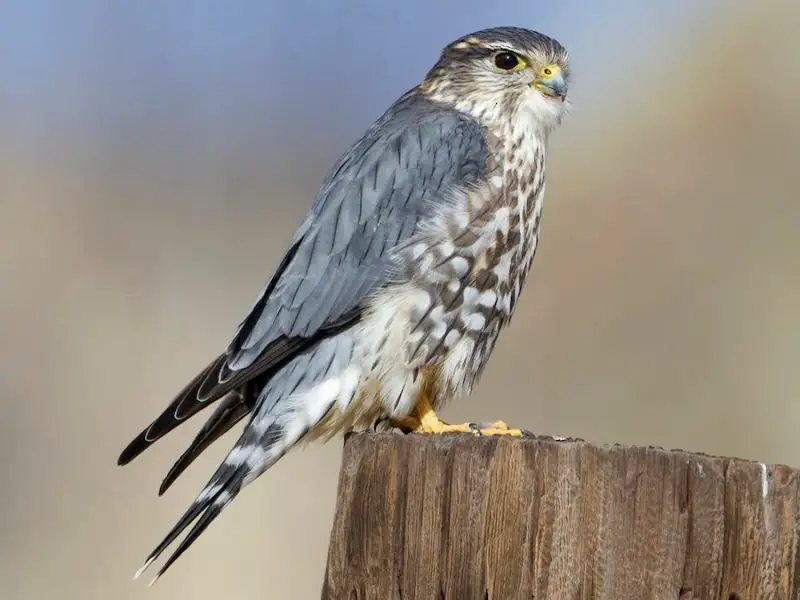
The Merlin is a compact, powerful falcon with a fierce hunting style. It has a dark, streaked chest, slate-gray or brownish back (depending on sex), and a relatively short, stocky body. Adults measure 9 to 13 inches long, with a wingspan of 20 to 26 inches. Unlike the colorful American Kestrel, Merlins have a more subdued and uniform coloration, giving them a robust, muscular appearance.
In Ohio, Merlins are primarily seen during migration in spring and fall. They favor open habitats such as grasslands, coastal lakefronts, and fields, especially near Lake Erie. Occasionally, they can be spotted in urban parks or golf courses during migration, but they do not typically breed in the state.
Merlins are aggressive bird hunters, often chasing down small songbirds in fast, twisting pursuits. Unlike Peregrine Falcons, which dive from great heights, Merlins rely on relentless pursuit flight, darting through the air at high speeds until they exhaust their prey. They mostly feed on sparrows, finches, and other small birds, though they occasionally eat insects and small mammals.
A fun fact about Merlins is that they were once nicknamed “pigeon hawks” due to their preference for hunting pigeons and doves. Despite their small size, they are fearless predators, sometimes chasing prey larger than themselves. Their bold and energetic nature makes them an exciting falcon to observe during Ohio’s migration seasons.
Gyrfalcon (Falco rusticolus)
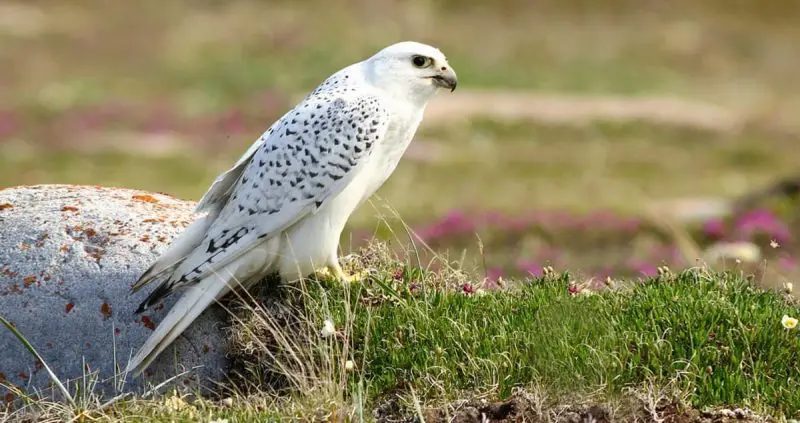
The Gyrfalcon is the largest falcon in the world and an extremely rare visitor to Ohio. It has a powerful, broad body with long, pointed wings and a robust chest. Plumage color varies widely, ranging from almost pure white to dark gray or brown, but most individuals seen in the lower 48 states are gray morphs. Adults measure 18 to 25 inches in length with wingspans between 48 and 64 inches, making them significantly larger than the Peregrine Falcon.
In Ohio, Gyrfalcons are only observed during winter, and even then, sightings are exceptionally rare. Most records occur in the northern part of the state, particularly along the Lake Erie shoreline. These falcons typically perch on open fields, marsh edges, or large industrial structures while scanning for prey. They are native to Arctic regions, so their appearance in Ohio usually happens during irruptive years when prey shortages push them south.
Gyrfalcons are powerful hunters that specialize in taking medium to large birds such as ducks, gulls, and pigeons. They also hunt mammals like rabbits and squirrels. Unlike the Peregrine Falcon, which dives from great heights, Gyrfalcons often chase their prey in level flight, relying on endurance and strength rather than extreme speed.
A fun fact about the Gyrfalcon is its historical significance—it was a prized bird in medieval falconry, reserved exclusively for royalty and nobility due to its rarity and strength. Spotting one in Ohio is considered a lifetime birding achievement because of its elusive and unpredictable appearances.
Prairie Falcon (Falco mexicanus)
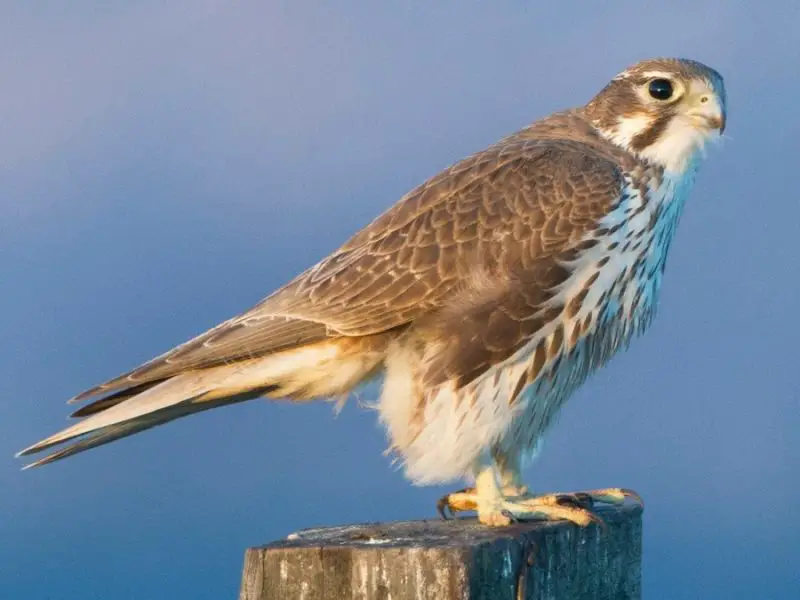
The Prairie Falcon is a medium-sized falcon rarely seen in Ohio, but occasional vagrant sightings have been recorded. This species is sandy brown above and pale below with dark armpit markings, which help distinguish it from the Peregrine Falcon. Adults range from 15 to 18 inches long, with wingspans of about 35 to 44 inches. Its slim build and pointed wings give it a graceful appearance in flight.
Prairie Falcons prefer open landscapes such as deserts, grasslands, and agricultural plains, making them uncommon in Ohio’s mostly forested and urban environments. Rare individuals are occasionally spotted during winter in wide-open farmland or along large lakeshores, where they hunt for prey. These appearances are extremely sporadic, and the species does not breed in the state.
In the wild, Prairie Falcons feed mainly on small mammals such as ground squirrels, rabbits, and occasionally small birds. They often use a surprise attack strategy, flying low to the ground before quickly swooping up to ambush their prey. This differs from the Peregrine Falcon’s high-speed stoops and makes them more adapted to hunting in open plains.
A fun fact about the Prairie Falcon is its incredible heat tolerance. Unlike most falcons that thrive in cooler climates, this species is specially adapted to arid environments, where it uses rocky cliffs and canyons as nesting sites. Seeing one in Ohio is a rare treat, offering birdwatchers a glimpse of a falcon more at home in the western United States.
FAQs About Falcons in Ohio
What Falcons Can Be Found in Ohio?
Ohio is home to five species of falcons which include the Peregrine Falcon, American Kestrel, Merlin, Gyrfalcon, and Prairie Falcon. The first three species are frequently seen across the state, while the Gyrfalcon and Prairie Falcon are rare visitors that appear mostly in winter or during migration seasons.
Where Is the Best Place to See Falcons in Ohio?
Peregrine Falcons are often found in urban areas such as Cleveland, Columbus, and Cincinnati where they nest on tall buildings and bridges. American Kestrels are commonly seen in farmlands, grasslands, and open fields. Merlins are more visible along Lake Erie during migration, while Gyrfalcons and Prairie Falcons are occasionally observed in northern Ohio’s wide open farmlands.
When Is the Best Time to Spot Falcons in Ohio?
Falcons can be seen in Ohio throughout the year, but the best time depends on the species. Peregrine Falcons and American Kestrels are year-round residents. Merlins migrate through the state in spring and fall. Gyrfalcons and Prairie Falcons are most likely to appear in winter, particularly in the northern regions near Lake Erie.
What Do Falcons Eat in Ohio?
Falcons in Ohio primarily feed on birds, small mammals, and insects. Peregrine Falcons often hunt pigeons and shorebirds, especially in cities. American Kestrels feed on grasshoppers, mice, and small songbirds. Merlins specialize in chasing small birds, while Gyrfalcons and Prairie Falcons hunt larger prey, including ducks and rabbits, when they visit Ohio.
Are Falcons Protected in Ohio?
Yes, all falcons in Ohio are protected under state and federal wildlife regulations. The Peregrine Falcon, once an endangered species, has made a strong recovery due to conservation efforts. It is illegal to harm, capture, or disturb these birds or their nests in the state.

